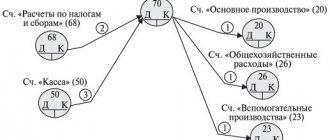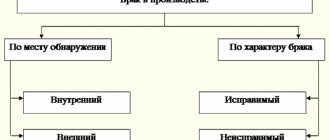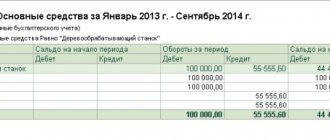Debit 76 Credit 76: what does it mean
If the posting of Dt 76 Kt 76 is made in the correspondence of accounts, this is an offset of mutual claims.
When, for example, he buys stationery from, and from - ready-made semi-finished products for employee lunches, at the same time a debt arises to and - to. The Civil Code allows in this case to offset the obligations of two companies (Article 410 of the Civil Code of the Russian Federation). To do this, the following conditions must be met:
- Direct presence of counterclaims. That is, companies must have at least 2 agreements between themselves: one of them is a creditor, and the other is a debtor. Likewise for .
- The requirements of companies must be uniform.
- Set-off is permitted upon the maturity of one of the companies' obligations. If the period is not specified in the contract or is determined by the moment of demand, offset can be made at any time.
The Civil Code of the Russian Federation requires for offset to be carried out an application from one of the parties to the transaction or the drawing up of an act of offset. Companies can also carry out a partial offset - for the amount of the smallest mutual debt.
On the date of receipt of the application for offset or signing of the act of offset, company accountants must make the following entry:
Dt 76 Kt 76 - for the amount of offset obligations (reflects the termination of the counter obligation to pay for goods, works, services by offsetting mutual claims).
Example 1
in the 3rd quarter of 2021, I purchased archival racks worth RUB 441,250. And “Paper Yard” bought several used refrigerators for the office kitchen for 353,000 rubles. Based on the results of the quarter, as of September 30, 2020, the firms signed a netting act for RUB 353,000. Let us assume that “Fas” take into account transactions between themselves on account 76, since for both companies these transactions are not the main activity.
In the accounting records, both companies will reflect the offset as follows: Dt 76 Kt 76 - in the amount of 353,000 rubles. (offset has been made).
Then the initial debit balance on account 76 as of 10/01/2020 will be 88,250 rubles. And the credit opening balance on the same day will be similar, that is, “Fastmil” will still owe “Bumazhny Dvor” 88,250 rubles.
In our example, debts for goods already delivered were closed by offset. Therefore, this offset did not affect VAT in any way. But the parties can also read out advances. Moreover, depending on the situation, the procedure for working with VAT will be different. A ready-made solution from ConsultantPlus will help you avoid making mistakes in this tax. If you do not already have access to this legal system, you can get a full access trial for free.
What to do if the creditor has not paid his debt, read the article “Writing off accounts payable with an expired statute of limitations.”
Accounting on account 91
Other income of the organization is reflected in the credit of account 91, in particular, by the following accounting entries (Order of the Ministry of Finance dated October 31, 2000 No. 94n):
Debit of accounts 51 “Settlements accounts”, 62 “Settlements with buyers and customers”, 76 “Settlements with various debtors and creditors" - Credit account 91-1
Accrued VAT on other transactions is reflected as follows:
Debit account 91-3 – Credit account 68 “Calculations for taxes and fees”
And other expenses are accounted for in the debit of account 91 with the following basic entries:
Debit account 91-2 – Credit accounts 01 “Fixed assets”, 10 “Materials”, 51, 60 “Settlements with suppliers and contractors”, 76
Like account 90, the account for other income and expenses does not have a balance at the end of the month. Therefore, on the last day of the month, transactions are generated to close account 91 with the difference assigned to account 99 “Profits and losses”. So, if profit was generated from other operations for the month, the posting will be as follows:
Debit account 91-9 – Credit account 99
And if the debit turnover of account 91 for the month exceeded the credit one, i.e., a loss was incurred on other transactions for the month, the posting will be reversed:
Debit account 99 – Credit account 91-9
The balance sheet reform carried out at the end of the year provides for the zeroing of all subaccounts to account 91.
Account 91 “Other income and expenses” is used to display information on non-operating income and arising costs of the company for operations not related to normal activities.
Account 91 in accounting is used by legal entities to collect information on the company’s income and expenses that are not related to normal activities.
Sch.91 is considered to be active-passive. The loan displays information about income from the following operations:
- provision of temporary use of the company’s own assets (corresponds with the accounts of mutual settlements and funds);
- provision of patents, intellectual property products, etc. for a fee;
- participation in the authorized capital of third-party companies;
- sale of own equipment;
- surplus goods and materials identified during the inventory;
- write-off of expired accounts payable;
- interest paid by counterparties for loans and credits provided;
- exchange differences;
- profit of previous years accepted in the reporting period, etc.
Account debit – reflection of the company’s other expenses:
- bank commission costs;
- shortages and damage to products and goods and materials, for which the perpetrators have not been identified or there is a court conclusion refusing to reimburse costs;
- fines and penalties required to be paid due to violations of the terms of agreements with counterparties;
- charity;
- interest on loans and borrowings;
- costs associated with the write-off of fixed assets and other assets of the company (with the exception of cash);
- write-off of expired accounts receivable;
- legal costs;
- exchange differences;
- losses of previous years accepted in the reporting period, etc.
Debit 76 Credit 51
An accountant can post Dt 76 Kt 51 in the following cases:
- Payment has been made for property or personal insurance of personnel. Dt 76.1 Kt 51 - 10,000 rub. The accountant paid the insurance company the annual fee for the employee's insurance. Then, when receiving money from the insurance company upon the occurrence of an insured event, the Fastmil accountant will make a debit entry to account 51 in correspondence with account 76. And the accrual of insurance compensation to the employee will be reflected by entry Dt 76 Kt 73.
- The accounts payable to the counterparty has been repaid. A company can record settlements with suppliers both on account 62 and 76. In practice, accountants most often record on account 76 secondary counterparties, settlements with which occur infrequently.
- The supplier is paid for the claim or fine. In this case, mutual fines of 2 companies can be offset by posting Dt 76 Kt 76.
Example 2
I discovered that one of the archival shelves purchased from Bumazhny Dvor was deformed. And Bumazhny Dvor, in turn, filed a claim for the short supply of refrigerators.
According to the agreement between the parties, they are obliged to pay the counterparty a fine in the amount of 10,000 rubles. and remove the goods at your own expense. However, Bumazhny Dvor has the right to expect to receive monetary compensation from Fastmil for shortfalls in delivery. The fine is 5,000 rubles. The parties signed an act of mutual settlement for part of the mutual claims in the amount of 5,000 rubles.
In accounting it will be reflected as follows: Dt 76 Kt 76 - in the amount of 5,000 rubles. (mutual claims between are taken into account).
The paper yard accountant will make the following entries in accounting:
- Dt 76 Kt 76 - in the amount of 5,000 rubles. (part of the fine is offset against the due monetary compensation);
- Dt 76.2 Kt 51 - in the amount of 5,000 rubles. (a fine was paid for the supply of low-quality archival shelving).
Important! Tip from ConsultantPlus If you refuse a low-quality product and return it to the supplier, you have the right to return the money for it... The procedure for returning money can be specified in the contract or a separate agreement. If it is not indicated anywhere, ask the supplier in writing to return the money. In case of non-return, send him a claim and then file a lawsuit. For detailed refund procedures, see K+ after receiving a free trial access.
Settlements on account 76: assignment agreement
Posting Dt 76 Kt 76 is drawn up by an accountant when concluding an assignment agreement or assignment of a claim. This is an agreement under which one company (assignor) sells to another company (assignee) the right to claim debt from a third company (Article 382 of the Civil Code of the Russian Federation). Moreover, the debtor does not appear in the assignment agreement itself. Let's look at an example of how settlements under an assignment agreement are accounted for by each participant.
Example 3
bought the right to demand debt from IP Kuznetsova E.I. The amount of debt of IP Kuznetsova E.I. is 400,000 rubles. Bumazhny Dvor sells this debt for 350,000 rubles.
Since before this transaction Fastmil owed 350,000 rubles, Bumazhny Dvor and Fastmil offset the debts to each other.
The accountant reflected the acquisition of debt as follows:
- Dt 58 Kt 76 - in the amount of 350,000 rubles. (the debt of individual entrepreneur E.I. Kuznetsova was acquired under an assignment agreement);
- Dt 76 Kt 76 - in the amount of 350,000 rubles. (the purchase of the debt of E. I. Kuznetsova was counted against the debt of Bumazhny Dvor).
If an individual entrepreneur transfers money, the accountant will make the following accounting entries: Dt 51 or 50 Kt 76 - in the amount of 400,000 rubles. (debt received from individual entrepreneur E. I. Kuznetsova).
The accountant will determine the financial result of the transaction as follows:
- Dt 76 Kt 91.1 - in the amount of 400,000 rubles. (the amount of repaid debt is included in the company’s income);
- Dt 91.2 Kt 58 - in the amount of 350,000 rubles. (the cost of the acquired right of claim is included in expenses).
The credit balance on account 91 is the company’s profit from the purchase of the debt of IP Kuznetsova E.I. in the amount of 50,000 rubles.
In turn, the Bumazhny Dvor accountant will reflect the receipt of money from the sale of stuck accounts receivable as follows:
- Dt 76 Kt 91.1 - in the amount of 350,000 rubles. (reflects the proceeds from the sale of the debt of IP Kuznetsova E.I.);
- Dt 91.2 Kt 62 - in the amount of 400,000 rubles. (the debt of individual entrepreneur E.I. Kuznetsova was written off).
“Paper Yard” received a loss of 50,000 rubles.
How VAT is calculated for all parties to the assignment agreement, see ConsultantPlus. Get free trial access and go to the Ready Solution.
Features of accounting for transactions with cash currency
Home Favorites Random article Educational New additions Feedback FAQTransactions with foreign currency for settlements with legal entities and individuals, and the work performed and services provided are prohibited by law. However, there may be transactions with cash currency when employees of an enterprise travel abroad. In this case, the score is 50.1
a second-order subaccount is opened 2. The receipt and issue of cash currency is formalized with incoming and outgoing cash orders in the usual manner.
Orders are issued in the payment currency, and entries are made in the cash book both in the payment currency and in rubles at the exchange rate of the Central Bank of the Russian Federation. When sending employees of an enterprise abroad, cash received from the current currency account D-50.1.2 K-52 is issued to the sub-account D-71.2 K-50.1.2 .
When carrying out current foreign exchange transactions, as a result of changes in the foreign currency exchange rate, exchange differences arise, which are included in other income or expenses of the enterprise:
D-50.1.2 K-91.1 for the amount of positive exchange rate difference;
D-91.2 K-50.1.2 for the amount of negative exchange rate difference.
The amount of exchange rate difference is understood as the difference in the exchange rate of the ruble against a foreign currency on the last day of the reporting period and on the date of the business transaction, that is, exchange rate differences arise due to changes in the official foreign currency exchange rate for the period between the date of the business transaction and the date of settlements for it .
Accounting for monetary documents
Cash documents are accounted for in the subaccount of the same name 50.3 “Cash documents”
.
The organization's cash desk can store not only cash, but also securities, as well as monetary documents. The debit of account 50.3
reflects the balance of monetary documents in the enterprise's cash desk at the beginning and end of the reporting period, and the receipt of monetary documents at the cash desk.
of account 50.3
reflects the disposal of monetary documents.
Cash documents must be kept at the cash desk of the enterprise, their movement is documented with incoming and outgoing cash orders, which are then recorded in the book for recording the movement of cash documents, form No. KO-5.
Monetary documents are accounted for at face value. Analytical accounting of monetary documents is carried out by their types, and synthetic accounting is carried out on account 50.3
. Wiring
D-50.3 K-50.1 vouchers to sanatoriums and holiday homes, paid in cash.
When issuing vouchers to employees free of charge or with partial payment of the cost, the following entries are made:
D-50.1 K-50.3 for the amount of partial payment;
D-84 K-50.3 for the amount charged to the organization’s account.
When purchasing postage stamps and travel tickets, make a note:
D-50.3 K-50.1, 51, 76.
In the future, their cost is written off as they are spent and attributed to the costs of the enterprise D-20, 23, 25, 26, 44 K-50.3 or attributed to the retained earnings account D-84 K-50.3 , depending on the nature of the expenses.
Strict reporting forms located at the enterprise’s cash desk must be taken into account in the balance on account 006 “strict reporting forms”
, these include forms of work books, diplomas, certificates, etc.
In accordance with the Directive of the Central Bank of the Russian Federation “On the maximum amount of cash settlements and the expenditure of cash received at the cash desk of a legal entity or individual entrepreneur,” cash settlements in the Russian Federation between legal entities, as well as between a legal entity and a citizen engaged in entrepreneurial activity without education legal entity (hereinafter referred to as an individual entrepreneur), between individual entrepreneurs related to the implementation of their business activities, within the framework of one agreement concluded between these persons, can be made in an amount not exceeding 100 thousand rubles.
Main correspondence of accounts for account 50 “Cashier”
presented in the table:
| Contents of operation | D | TO |
| 1. Cash was received at the cash desk from the current account by check. | ||
| 2. Cash was received at the cash desk from the buyer for goods and products sold. | ||
| 3. Unused accountable amounts were returned to the cash desk. | ||
| 4. Received at the cash desk from employees: a) for moral damage caused; b) repayment of debt for goods purchased on credit | ||
| 5. Received at the cash desk from various debtors. | ||
| 6. Cash was deposited into the current account according to the announcement for a cash contribution. | ||
| 7. Paid to suppliers in cash. | ||
| 8. Employees' salaries were issued from the cash register. | ||
| 9. Issued from the cash register for reporting to the employees of the enterprise. | ||
| 10. Loans were issued from the cash register to employees of the enterprise. |
Debit 76 Credit 91
Posting Dt 76 Kt 91 is drawn up, as can be seen from the previous paragraph, in the event of receiving income from an assignment agreement. Also, an entry to the debit of account 76 in correspondence with the credit of account 91 is made in the case of leasing property, provided that this is a non-core activity of the company.
Unclaimed accounts payable, which were accounted for under Kt 76, after the expiration of the limitation period are written off in Kt 91.1 as other income of the enterprise.
Also, posting Dt 76 Kt 91 reflects amounts of money received in payment of fines and other sanctions from other companies. Let's remember the example about the fine, which is “Fas. The Fastmil accountant, upon receiving penalty payments from the Paper Yard, will make the following entries in the accounting:
- Dt 51 Kt 76.2 - in the amount of 10,000 rubles. (received a fine from the Paper Yard);
- Dt 76.2 Kt 91.1 - in the amount of 10,000 rubles. (the fine is included in income).
What are other income and other expenses
Accounting for other income and other expenses differs from accounting for these items in the ordinary course of business. Other income is not revenue, but other income. Other expenses do not form the cost of selling goods (work, services).
Content
Other income includes, for example:
- fines, penalties, penalties;
- proceeds from the rental of property, if the activity of leasing is not the main activity of the organization;
- coursework;
- other types of income, since clause 7 of PBU 9/99 contains an unlimited list of them.
Other expenses in accounting are, including:
- from the sale of fixed assets;
- interest on loans received;
- the amount of asset depreciation;
- losses from previous years;
- other types, since in clause 11 of PBU 10/99 the list of them is open. In fact, these include any non-fixed costs that arise periodically in the activities of an organization.
Other accounting is carried out using synthetic account 91 (Order No. 94n dated October 31, 2000) in the context of subaccounts 91-1, 91-2, respectively, and 91-9. For example:
| Other supply | |
| D 62 (76) K 91 | from suppliers and other contractors |
| Dt 51 Kt 91 | Interest accrued on the balance of money in the account |
| Other expenses, postings | |
| D 91-2 K 01 | the residual value of the sold fixed assets is recognized |
| D 91-2 K 60 (52, 62, 76) | negative exchange rate difference is taken into account |
| D 91-2 K 63 | reflects the creation of a reserve for doubtful debts |
| D 91-2 K 66 | interest on the loan is recognized |
| D 91-2 K 76 | penalty payable to the counterparty |
Accounting is carried out on an accrual basis throughout the year with monthly closure of the subaccount. 91-1 and subaccount. 91-2 for subaccount. 91-9. Comparing the debit and credit turnover of the account. 91 per month, we get financial results from other operations. It is reflected in the subscore 91-9. Other income and expenses are written off, posting:
- Dt 91-9 Kt 99 - profit for the month is reflected;
- Dt 99 Kt 91-9 - loss for the month is reflected.
At the end of the reporting year, subaccounts of accounts 91, except 91-9, are closed.
How other expenses are recognized in accounting is established in PBU 9/99:
- payments for violation of the terms of contracts during the period when the court made a decision on their collection or during the period in which they were recognized as a debtor;
- creditor in the period in which the claim period expired;
- revaluation of assets in the period in which the revaluation date falls;
- other receipts - as they are generated (identified).
Expenses other than the main type of activity are recognized in accounting in the manner established in paragraphs 16, 17 and 18 of PBU 10/99.
Other in the income statement:
- reflected in: interest receivable;
- other income;
- interest on loans and credits received;
- other expenses;
- this is allowed by the PBU;
Legal documents
- PBU 9/99
- PBU 10/99
- Order No. 94n dated October 31, 2000
Results
The debit of account 76 reflects various transactions: personnel insurance, settlements of claims and fines issued to counterparties, deposited amounts, the amount of debt purchased from another company. Posting Dt 76 Kt 76 reflects transactions carried out under the assignment agreement. When offsetting, a posting is also made Dt 76 Kt 76 .
You can find more complete information on the topic in ConsultantPlus. Free trial access to the system for 2 days.










